Lenovo ThinkStation P300 Workstation Review: Haswell plus Quadro
by Ian Cutress on November 4, 2014 10:00 AM EST- Posted in
- Systems
- Intel
- Lenovo
- Seagate
- Quadro
- Workstation
- Haswell
- desktops
- Enterprise
- NVIDIA
System Benchmarks
Power Consumption
Power consumption was tested on the system at the wall. This method of power reading allows us to compare the power management of the UEFI and the board to supply components with power under load, and includes typical PSU losses due to efficiency. These are the real world values that consumers may expect from a typical system (minus the monitor).

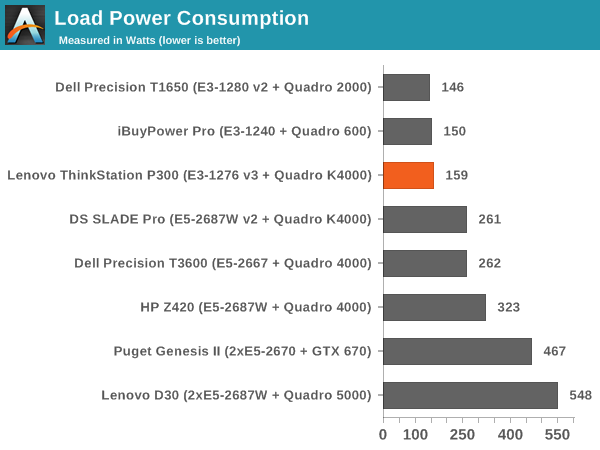
Power consumption on the P300 was pretty amazing due to the very efficient power supply used.
Windows 7 POST Time
Different motherboards have different POST sequences before an operating system is initialized. A lot of this is dependent on the board itself, and POST boot time is determined by the controllers on board (and the sequence of how those extras are organized). As part of our testing, we look at the POST Boot Time using a stopwatch. This is the time from pressing the ON button on the computer to when Windows 7 starts loading. (We discount Windows loading as it is highly variable given Windows specific features.)
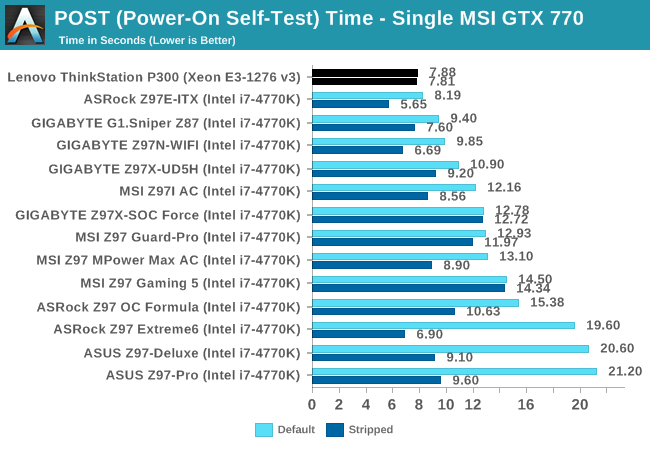
POST Times were also right on the money, giving some of our best POST times ever.
Rightmark Audio Analyzer 6.2.5
Rightmark:AA indicates how well the sound system is built and isolated from electrical interference (either internally or externally). For this test we connect the Line Out to the Line In using a short six inch 3.5mm to 3.5mm high-quality jack, turn the OS speaker volume to 100%, and run the Rightmark default test suite at 192 kHz, 24-bit. The OS is tuned to 192 kHz/24-bit input and output, and the Line-In volume is adjusted until we have the best RMAA value in the mini-pretest. We look specifically at the Dynamic Range of the audio codec used on board, as well as the Total Harmonic Distortion + Noise.

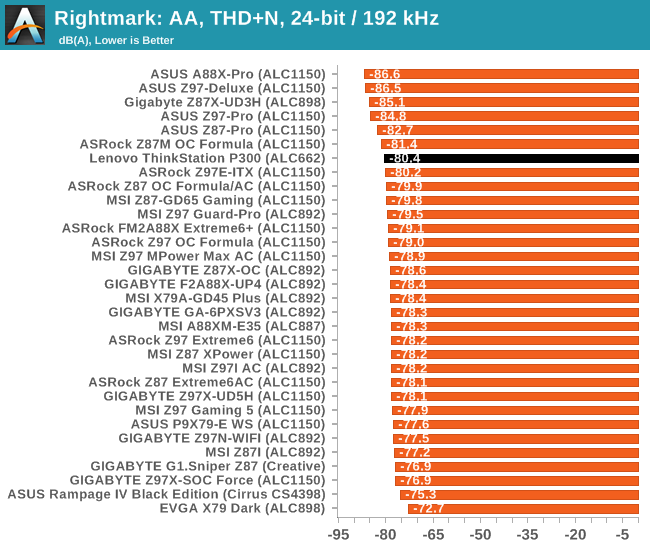
Unfortunately the audio performance for SNR was rock bottom due to the laptop-class codec used. THD+N was reasonable, although just above the median.
USB Backup
For this benchmark, we transfer a set size of files from the SSD to the USB drive using DiskBench, which monitors the time taken to transfer. The files transferred are a 1.52 GB set of 2867 files across 320 folders – 95% of these files are small typical website files, and the rest (90% of the size) are small 30 second HD videos. In an update to pre-Z87 testing, we also run MaxCPU to load up one of the threads during the test which improves general performance up to 15% by causing all the internal pathways to run at full speed.
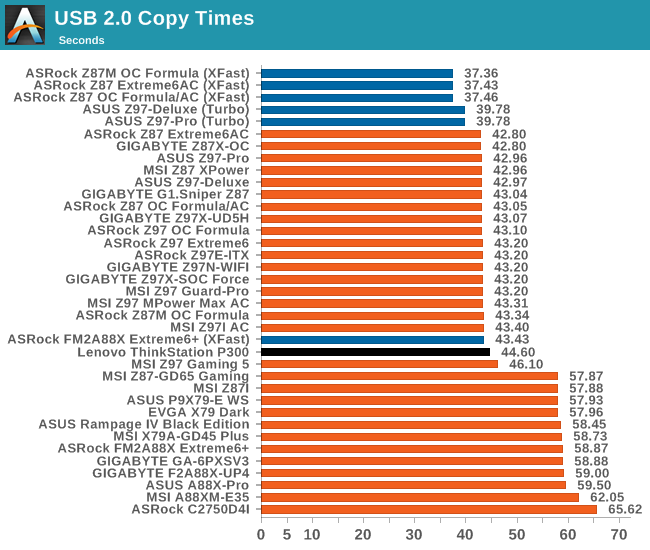
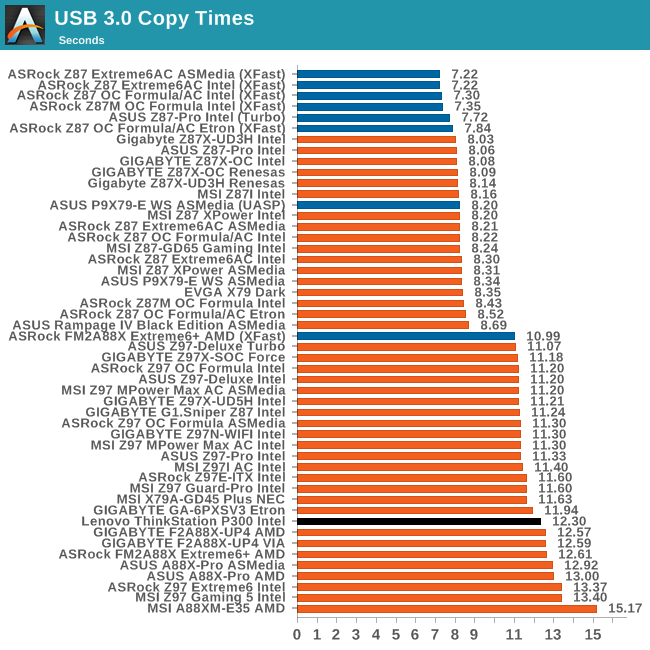
USB Performance seemed to lag behind the other motherboards that also accept Haswell CPUs.
DPC Latency
Deferred Procedure Call latency is a way in which Windows handles interrupt servicing. In order to wait for a processor to acknowledge the request, the system will queue all interrupt requests by priority. Critical interrupts will be handled as soon as possible, whereas lesser priority requests such as audio will be further down the line. If the audio device requires data, it will have to wait until the request is processed before the buffer is filled.
If the device drivers of higher priority components in a system are poorly implemented, this can cause delays in request scheduling and process time. This can lead to an empty audio buffer and characteristic audible pauses, pops and clicks. The DPC latency checker measures how much time is taken processing DPCs from driver invocation. The lower the value will result in better audio transfer at smaller buffer sizes. Results are measured in microseconds.

DPC Latency for the system was also relatively poor. Intel's 9-series made us rethink the milestone in terms of a good level of performance from 200 microseconds to 100 microseconds. The P300 hits the old target rather than the new one.










55 Comments
View All Comments
edzieba - Tuesday, November 4, 2014 - link
I recognise that Al heatsink! Lenovo plonk them on the secondary CPU in the C20 and C30 too.I really wish Lenovo would invest in backplanes for their drives, but at least the sideways mount with connectors facing you is better than the horrific mess at the bottom of the C20/30.
TETRONG - Wednesday, November 5, 2014 - link
Completely pointless system especially if it's non ECC memory.The truth is that you could build a system that would crush this with an overclocked i5 and a 970 for half the price + it would be upgradeable and running DDR4.
There's nothing magical about Xeons and Quadros..total bullshit unless you absolutely need DP.
Anandtech should build the aforementioned system to embarrass all these clowns.
They could even hackintosh it to piss on the Mac Pro.
TETRONG - Wednesday, November 5, 2014 - link
Sorry, DDR3 with i5 or DDR4 with a 5820Knwai2208 - Wednesday, November 5, 2014 - link
A Xeon E3 system with non-ECC memory means it is just a i7 machine with a Xeon label on it.NanoTube1 - Wednesday, November 5, 2014 - link
To sum it up: a poor, ugly, cheap build...Dr.Neale - Wednesday, November 5, 2014 - link
I would use 2 or 4 sticks of Samsung 8GB DDR3L-1600 1.35V ECC UDIMM, model M391B1G73BH0-YK0, which go for $90 at oemPCworld.But then again, I would also roll my own using an ASUS P9D WS motherboard (Intel C226 chipset, ATX, supports ECC, unlike ASUS Z97 WS) and an AMD FirePro W7100 (K4200 level: 256-bit 4GB) or W8100 (K5200 level: 512-bit 8GB) GPU. Although the recently-released W7100 isn't listed on NewEgg just yet, right now you could get the W8100 instead, at roughly the same cost, by taking advantage of AMD's current half-price FirePro promo (which ends Jan. 15, 2015).
Also, I'd use a SeaSonic SS-520FL2 fanless 520W 80+Platinum PSU, and put AeroCool DS Dead Silence Case Fans (available at FrozenCPU) in a Fractal Designs Arc Midi R2 mid-tower ATX case (which has a tinted window).
I'd stick with the Intel Xeon e3-1276 v3 CPU, but cool it with a ThermalRight Archon IB-E X2 single-tower cooler (also available at FrozenCPU). Using the double-tower ThermalRight Silver Arrow IB-E instead would run maybe 2° C cooler, but 2 dBA louder, according to reviews I've read, but using the Archon IB-E X2 guarantees zero clearance issues on the motherboard.
For an SSD, the pro-sumer Samsung 850 Pro (used in a UPS-backed system) or the enterprise Samsung 845DC Pro are both viable options. Both use next-generation MLC V-NAND, with all its advantages.
But all this is only IF you happen to need an entry-to-mid-level Work Station RIGHT NOW. Broadwell 14nm Xeon e3-1200 v4 series Socket 1150 CPUs are about 6 months away (everything else could stay the same), and Skylake 14nm Xeon e3-1200 v5 series Socket 1151 CPUs are about 12 months away (but they would need a next-generation motherboard with an Intel C236 Greenlow chipset, which requires DDR4 2133 1.20V ECC RDIMM memory). However, this setup could use PCIe NVMe SSDs, and could (probably, assuming LGA isn't supplanted by BGA) be later upgraded with a Cannonlake 10nm Xeon e3-1200 v6 series CPU.
Also, by waiting, you could buy Windows 10 instead of Windows 7 for your OS.
Anyways, just my thoughts on a decent bang-for-the-buck, near-silent Work Station build.
P.S. A WASD Code backlit mechanical keyboard might be a nice cherry-on-top touch.
akula2 - Wednesday, November 5, 2014 - link
I build my own hi-end (X79/Z97) and ultra (Xeon) workstations because of hardware choice, saving on prices and cutting off vendor costs. Each custom-build workstation costs a lot, hence a lot of saving considering the number of builds.Dr.Neale - Wednesday, November 5, 2014 - link
The Intel Z97 chip set does NOT support ECC memory. Only Haswell motherboards with an Intel C220 series chipset support ECC memory, and then only with a Xeon CPU.For example, ASUS P9D WS (C226) motherboard supports ECC memory (with a Xeon CPU); whereas, ASUS Z97 WS (Z97) does NOT (even with a Xeon CPU). I'm not sure whether or not it will accept ECC UDIMMS, but I am sure the ECC function is disabled, using Z97 chipset.
otherwise - Tuesday, November 11, 2014 - link
When I saw that the ASUS Z97 WS supported ECC I also found that incredibly odd, and wrote an e-mail to their support address. They got back to me a couple days later and assured me it did support ECC with a Xeon. I still don't really trust them, and if I was to go that route I would just get a C226, but I'd love to see someone test their claim.Scalarscience - Wednesday, November 5, 2014 - link
Of course it's possible to beat prebuilt computers in terms of component choice, price or both. But why waste your breath? Do you think people out there are going to read this article, then read the comments and go "OH WOW I HAD NO IDEA??!!". Rather, this is like an echo chamber...the IT & purchasing people this article is aimed at will probably never even read the comments as they're parsing multiple reviews to make a purchasing (NOT building) decision.Ie, systems like this are built for entry level systems for office situations where there's either no IT or it's not worth the time to roll a custom solution. And it's been that way since...oh about 1988...
I see the same thing in Apple Mac reviews, and it just boggles the mind. Fwiw I've run custom built XEON hardware since the PPro era (and before that I had a serverworks dual P133, which was very oddball). I used to use SGI & HP workstations at 'work' and Xeons at home, then I used Xeons at work running NT, then Linux, and now Linux & OSX on Macs...so yea obviously this review system wouldn't be my first choice for Autodesk Smoke, After Effects or Maya. But on a time crunch if I needed an intern or two to pick up some slack a short lease might just help finish a project....